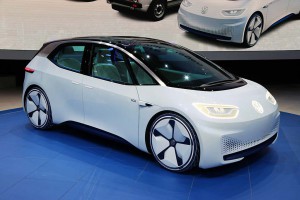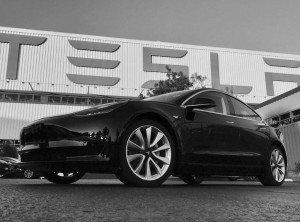
Volkswagen says when its I.D. hits the market in two years, it'll be cheaper than its primary competitor, the Tesla Model 3.
It hasn’t even hit a dealershi, er, retail store yet, but the Tesla Model 3 is already generating a strong response from future competitors, including Volkswagen which said its mass-market model, the I.D., will be priced lower than the Tesla entry.
Production on the Model 3 began last week, which is supposed to be Tesla’s entry-level model at a base price of $35,000. However, once a few additions are made, the costs quickly escalate past $40,000 and closer to $50K, claim VW executives.
The Golf-sized I.D. is expected to start at $27,000 and boast a range of 249 to 373 miles, depending upon different variables. It would come in at 168 horsepower. The Model 3 is expected to get about 215 miles to a full charge.
While VW officials are clucking up a storm, let’s not forget the already-on-the-road Chevrolet Bolt, that can be had — for now — at around $30K after federal tax credits are applied. The Model 3 is also eligible for the same credits.
(VW declares the “future is electric.” Click Here for the story.)
Volkswagen plan to have more than 30 EVs road ready by 2025, included in that could be I.D. Buzz, which is based off VW’s eternally popular Microbus. The company will have the I.D. expects to be building 1 million EVs annually by 2025 and said it plans to offer an autonomous version of the I.D. by then.

A new Model 3 in front of Tesla's Fremont, California plant, which began producing the new entry-level model last week.
“The future is electric,” declared Volkswagen Group CEO Matthias Mueller, during the annual meeting in Hanover, not far from the automaker’s headquarters in Wolfsburg. And VW, he added, “intend(s) to be the number one in e-mobility by 2025.
That future may be bolstered by VW’s most recent introduction, the I.D. Crozz. Initially described as a concept during the Shanghai Motor Show, more recently, VW executives have been saying it will likely be part of the company’s line-up.
(Click Here for more on the VW I.D. Crozz.)
With its coupe-like crossover body, VW is describing the new I.D. Crozz as a “key pillar” of its new electrification strategy. The electrified ute draws power from an 83 kilowatt-hour lithium-ion battery pack mounted in the vehicle’s floor, a move meant to lower its center of gravity and free up space for passengers and cargo.
The battery pack is paired with two electric motors. The one in the rear produces 201 horsepower, with the motor on the front axle producing an additional 101 horsepower. Together, VW says the pair of motors can launch the I.D. Crozz from 0 to 60 in less than 6 seconds, with a top speed of 112 mph.
However, Tesla has a big advantage: it’s future is now. The company produced more than 80,000 Model S and Model X vehicles in 2016 and expected to break the 100,000 unit mark this year with the new Model 3 online.
(To see more about Musk’s plans for more car and battery plants, Click Here.)
The goal for Tesla production is 500,000 units by the end of 2018, with the Model 3 accounting for 80% of that, and there are more products in the company’s development pipeline, including a pickup truck, a downsized SUV and a semi truck, according to Elon Musk, Tesla’s founder. Also on the agenda is a revised version of the company’s first vehicle, the Roadster with a significant series of updates that may include a sub 2-second 0-to-60 time.

Reminds me of a story:
A shopper complains to the store owner that his potatoes are too expensive. “You’re charging 20 cents a pound and Walmart is only charging 15 cents a pound.” “Well, buy them at Walmart.” “They are out of stock at Walmart.” Well, when I’m out of stock, I only charge 10 cents a pound.”
I’m confused by your report on the horsepower of the upcoming Volkswagen I.D. — Paragraph 3 says of the I.D. “It would come in at 168 horsepower.” Paragraph 9, however, says, “The battery pack is paired with two electric motors. The one in the rear produces 201 horsepower, with the motor on the front axle producing an additional 101 horsepower.” To the best of my knowledge, 201 plus 101 should equal 302 horsepower, not 168. Please clarify.
Thanks,
Doug